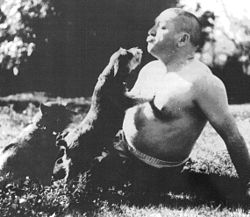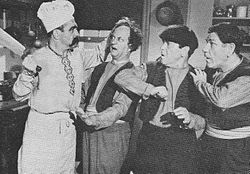- Curly Howard
-
For the DJ, see Curly Howard (DJ).
Curly Howard 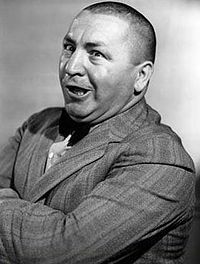
Howard in
Nutty but Nice (1940)Born Jerome Lester Horwitz
October 22, 1903
Bensonhurst, Brooklyn,
New York, United StatesDied January 18, 1952 (aged 48)
San Gabriel, California,
United StatesCause of death Stroke Other names Curley Howard
Jerry HowardOccupation Actor/Comedian Years active 1928–1946 Spouse Julia Rosenthal (m. 1930–1930)
Elaine Ackerman (m. 1937–1940)
Marion Buxbaum (m. 1945–1946)
Valerie Newman (m. 1947–1952)Website threestooges.net Jerome Lester "Jerry" Horwitz (October 22, 1903 – January 18, 1952), better known by his stage name Curly Howard, was an American comedian and vaudevillian. He is best known as a member of the American slapstick comedy team the Three Stooges, along with his older brothers Moe Howard and Shemp Howard, and actor Larry Fine. Curly is generally considered the most popular and recognizable of the Stooges.[1] He is well known for his high-pitched voice, vocal expressions ("nyuk-nyuk-nyuk!","woo-woo-woo!", "soitanly!" and barking like a dog), as well as his inventive physical comedy, improvisations, and athleticism.[2]
An untrained actor and natural comedian, Curly borrowed (and significantly exaggerated) the "woo woo" from "nervous" and soft-spoken comedian Hugh Herbert, but was otherwise an original and inspired performer. Curly's unique version of "woo-woo-woo" was firmly established by the time of the Stooges' second film Punch Drunks in 1934.[2]
Contents
Early life
Curly Howard was born Jerome Lester Horwitz in the Bensonhurst section of the Brooklyn borough of New York City. He was the fifth of the five Horwitz brothers and of Lithuanian Jewish ancestry. Because he was the youngest, his brothers called him "Babe" to tease him. The nickname stuck with him all his life, although when his older brother Shemp married Gertrude Frank, who was also nicknamed "Babe," the brothers started calling him "Curly" to avoid confusion.[3] His full formal Hebrew name was "Yehudah Lev ben Shlomo Natan ha Levi."[4]
A quiet child, Curly rarely caused problems for his parents (something older brothers Moe and Shemp excelled in). He was a mediocre student academically, but excelled as an athlete on the school basketball team. He did not graduate from high school, but kept himself busy with odd jobs and constantly followed his older brothers, whom he idolized. Curly was also an accomplished ballroom dancer and singer, and regularly turned up at the Triangle Ballroom in Brooklyn, occasionally bumping into George Raft.[2]
When Curly was 12, he accidentally shot himself in the left ankle while cleaning a rifle. Moe rushed him to the hospital and saved his life. The wound resulted in his leg being noticeably thinner, and he also suffered a slight limp. Curly was so frightened of surgery that he never had the limp corrected. While with the Stooges, he developed his famous exaggerated walk to mask the limp on screen.[2]
Curly was interested in music and comedy, and would watch his brothers Shemp and Moe perform as stooges in Ted Healy's vaudeville act. Curly also liked to hang around backstage, though he never participated in any of the routines.
Career
Early career and the Three Stooges
From an early age, Curly was always "in demand socially," as brother Moe put it.[2] He married his first wife, Julia Rosenthal, on August 5, 1930. The two divorced shortly afterwards.[5]
Curly's break onto the stage was as a comedy musical conductor in 1928 for the Orville Knapp Band. Moe later recalled that his performances usually overshadowed those of the band.[2] Though Curly enjoyed the gig, he watched as older brothers Moe and Shemp (and partner Larry Fine) made it big as some of Ted Healy's "stooges." Vaudeville star Ted Healy had a very popular stage act, in which he would try to tell jokes or sing, only to have his stooges wander on stage and interrupt him, or heckle and cause disturbances from the audience. By 1930, Healy and company appeared in their first feature film, Rube Goldberg's Soup to Nuts.[1]
Shemp, however, disliked Healy's abrasiveness, bad temper and heavy drinking.[2] In 1932, he was offered a contract at the Vitaphone Studios in Brooklyn. (Contrary to stories told by Moe, the role of "Knobby Walsh" in the Joe Palooka series did not come along until late 1935, after Shemp had been at Vitaphone for three years and had already appeared in almost thirty short subjects.) Shemp was thrilled to be away from Healy, but, as was his nature, worried incessantly about brother Moe and partner Larry. Moe, however, told Shemp to pursue this opportunity:
“ In 1932, Shemp got the opportunity to play the character Knobby in Joe Palooka pictures out on the coast. And it seemed like a great opportunity for Shemp. And he was reluctant about leaving, he said, 'Well, what are you gonna do for a third man?' I said, 'Shemp, don't worry about that. Grab your opportunity and we'll get the kid brother Curly in.' And Curly was working with a band called Orville Knapp and his Band, he was a comedy guest conductor. And it got a big laugh, so we got in touch with Curly and said, 'Give your man two weeks notice and come on, you're gonna join with us.'[6] ” 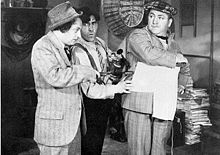 Curly models a girdle for Moe and Larry in A Plumbing We Will Go. This short was reportedly Curly's favorite film.[2]
Curly models a girdle for Moe and Larry in A Plumbing We Will Go. This short was reportedly Curly's favorite film.[2]
With Shemp gone, Moe suggested that Curly (then still known as Jerry) fill the role of the third stooge. However, Healy felt that Curly, with his thick, chestnut-red hair and elegant waxed mustache, did not look like a funny character. Curly left the room and returned minutes later with a shaved head (the moustache remained very briefly). Healy quipped, "Boy, don't you look girlie?" Moe misheard the joke as "curly" and all who witnessed the exchange realized that the nickname "Curly" would be a perfect fit. In one of the few interviews Curly gave in his lifetime, he complained about the loss of his hair: "I had to shave it off right down to the skin."[2] In 1934, MGM was building Ted Healy up as a solo comedian in feature films and Healy dissolved the act to pursue his own career. Like Shemp, the team of Howard, Fine and Howard were tired of Healy's alcoholism and abrasiveness and renamed their act the "Three Stooges." The same year, they signed on to appear in two-reel comedy short subjects for Columbia Pictures. The Stooges soon became the most popular short-subject attraction, with Curly playing an integral part in the trio's rise to fame.[2]
Prime years
By the end of the 1930s, Curly Howard was clearly the star of the Three Stooges.[1] His childlike mannerisms and natural comedic charm made him a hit with audiences, particularly children. He was famous in the act for having an "indestructible" head, which always won out by breaking anything that assaulted it, including saws. Although having no formal acting training, his comedic skills were exceptional. Many times, directors would simply let the camera roll freely and let Curly improvise. Jules White, in particular, would leave gaps in the Stooge scripts where Curly could improvise for several minutes.[2] By the time the Stooges hit their peak in the late 1930s, their films had almost become vehicles for Curly's unbridled comic performances. Classics like A Plumbing We Will Go, We Want Our Mummy, An Ache in Every Stake, and Cactus Makes Perfect display his ability to take inanimate objects (like food, tools, pipes, etc.) and turn them into comic genius.[2] Moe later confirmed that Curly forgetting his lines merely allowed him to improvise on the spot rather than stop the shot:
“ If we were going through a scene and he'd forget his words for a moment, you know. Rather than stand, get pale and stop, you never knew what he was going to do. On one occasion he'd get down to the floor and spin around like a top until he remembered what he had to say.[6] ” Curly also developed a set of reactions and expressions that the other Stooges would imitate long after he had left the act:
- "N'yuk, n'yuk, n'yuk" - Curly's traditional laughter, accompanied by a manic finger snapping routine, was often used when Curly had amused himself
- "Woob, woob, woob" - used when he was either scared, dazed, or flirting with a "dame"
- "N'gyahh-ahhh-ahhh!" - scare reaction (this was the most-often used reaction by the other Stooges after Curly's departure)
- "Ruff, ruff" - a dog bark, used to give an enemy a final push before departing the scene
- "Ah-ba-ba-ba-ba-ba-ba!" - used during his later years, a sort of nonsensical, high-pitched yelling that signifies being scared or overly excited.
Curly also had a number of physical attributes and skills he performed as a Stooge, including:
- Dancing in place and swinging his arms around himself, usually done when he is overtly excited.
- Kicking one leg backwards and shuffling back on his stationary foot, usually done when dancing or marching.
- A dismissive hand waving gesture, starting from his head and ending with an extended arm at who/whatever he is dealing with (one of his most recognizable traits)
On several occasions, Moe was convinced that rising star Lou Costello (a close friend of Shemp) was siphoning material from Curly. Costello was known to acquire prints of the Stooges' films from Columbia Pictures on occasion, presumably to study Curly. Inevitably, Curly's routines would show up in Abbott and Costello features, much to Moe's chagrin (it did not help that Columbia Pictures president Harry Cohn would not give the Stooges a chance to make feature-length films like contemporaries Laurel and Hardy, the Marx Brothers, and Abbott and Costello).[7]
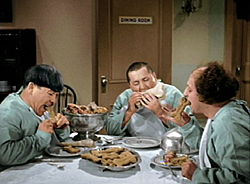 Curly (center) was in his glory while filming the dog-themed Calling All Curs. His love of dogs was unabated throughout his life.
Curly (center) was in his glory while filming the dog-themed Calling All Curs. His love of dogs was unabated throughout his life.
Slow decline
By 1944, Curly's energy began to wane. Films like Idle Roomers and Booby Dupes present a Curly whose voice was deeper and his actions slower. After the filming of Idiots Deluxe, Curly finally checked himself (at Moe's insistence) into Cottage Hospital in Santa Barbara, California on January 23, 1945 and was diagnosed with extreme hypertension, a retinal hemorrhage and obesity. Curly's ill health forced him to rest, leading to only five shorts released in 1945 (the normal output was six to eight films per year). It is also believed that Curly suffered the first in a series of mild strokes at this time.[2] Moe pleaded with Harry Cohn to allow Howard some time off upon discharge to regain his strength. Cohn would not halt the production of his profitable Stooge shorts and flatly refused Moe's request. Author Michael Fleming stated that "...it was a disastrous course of action."[1]
The first film produced after Curly's stroke was the lackluster If a Body Meets a Body, and his actions and mannerisms were noticeably slower. In the hands of a sympathetic director like novice Edward Bernds, Curly could produce decent work. This was because Bernds painstakingly devised ways that the ailing Stooge could still be the star without actually contributing a great deal. Films like Monkey Businessmen (in which Curly had to be coached by Moe on camera), Micro-Phonies and A Bird in the Head were examples of Bernds factoring in the reality that Curly was no longer in his prime.[1] Other directors, such as Jules White, simply shifted the action to Moe and Larry. Films like Beer Barrel Polecats and Uncivil War Birds were mediocre at best and clearly showed that Curly was suffering.[1]
Personal life
Curly's offscreen personality was the antithesis of his onscreen manic persona. An introvert, he generally kept to himself, rarely socializing with people unless he had been drinking (which he would increasingly turn to as the stresses of his career grew). In addition, he came to life when in the presence of brother Shemp. Curly could not be himself around brother Moe, who treated his younger brother with a fatherly wag of the finger. Never an intellect, Curly simply refrained from engaging in "crazy antics" unless he was in his element: with family, performing, or intoxicated.[2]
On June 7, 1937, Curly married Elaine Ackerman, who gave birth to their first child, Marilyn, the following year. The couple divorced in 1940. After this divorce, Curly gained a great deal of weight and developed hypertension. Curly was also insecure about his shaved head, believing it made him unappealing to women; he increasingly drank to excess and caroused as a coping mechanism. He took to wearing a hat in public to convey an image of masculinity, saying he felt like a little kid with his hair shaved off. However, he was popular with women all his life.[1] In fact, many who knew him said women were Curly's main weakness. Moe's son-in-law Norman Maurer even went so far as to say he "was a pushover for women. If a pretty girl went up to him and gave him a spiel, Curly would marry them. Then she would take his money and run off. It was the same when a real estate agent would come up and say 'I have a house for you,' Curly would sell his current home and buy another one."[2]
During World War II, for seven months out of each year, the trio's filming schedule would go on hiatus, which allowed them to make personal appearances. The Stooges entertained servicemen constantly, and the intense work schedule took its toll on Curly. He never drank while performing in film or on stage, as Moe would not allow it. However, once away from Moe's watchful eye, he would find the nearest nightclub, down a few drinks, and enjoy himself. His drinking, eating, and carousing increased. He had difficulties managing his finances, often spending his money on wine, food, women, homes, cars, and especially dogs and was often near poverty. Moe eventually helped him manage his money and even completed his income tax returns.[2]
Curly found constant companionship in his dogs and often befriended strays whenever the Stooges were traveling. He would pick up homeless dogs and take them with him from town to town, until finding them homes somewhere else on the tour.[1] When not performing, Curly would usually have a few dogs waiting for him at home as well.[8]
Moe urged Curly to find himself a wife, hoping it would convince his brother to finally settle down and allow his health to somewhat improve. After a two-week courtship, Curly married Marion Buxbaum on October 17, 1945, a union which lasted approximately three months. The divorce proceeding was a bitter one, exacerbated by exploitation in the local media. After this divorce, Curly's health began a rapid and devastating decline.[2]
Illness
By early 1946, Curly's voice had become even more coarse than before, and he had increasing difficulty remembering even the simplest dialogue. He had lost a considerable amount of weight and lines had creased his face. The quality of his performances seriously declined; as his strength and energy plummeted, his final twelve films became the nadir of a once-bright career.
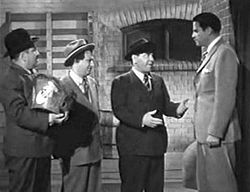 A thinner, ailing Curly (far left) struggles to get through his dialogue in Rhythm and Weep.
A thinner, ailing Curly (far left) struggles to get through his dialogue in Rhythm and Weep.
The extent to which Curly's performing had slipped can be clearly seen in the 1946 short Beer Barrel Polecats, which uses extensive stock footage from So Long Mr. Chumps, made five years earlier.
Two of Jules White's efforts—Three Loan Wolves and Rhythm and Weep—clearly display a sick Curly as indicated by his much slower movements. Ed Bernds, however, was lucky enough to capture the ailing Stooge on an "up" day when filming Three Little Pirates. Curly seemed better and there was some hope that his illness was finally under control. "I guess I should be thankful that Curly was in one of his 'up' periods," Bernds said later.[9] "In Three Little Pirates, he was terrific. It was the last flash of the old Curly."[2]
Half-Wits Holiday would be Curly's final appearance as an official member of the Stooges. The film was a remake of the comedy, Hoi Polloi. During filming on May 6, 1946, Curly suffered a severe stroke while sitting in director Jules White's chair while waiting to film the last scene of the day. When Curly was called by the assistant director to take the stage, he did not answer. Moe went looking for his brother: he found Curly with his head dropped to his chest. Moe later stated that Curly's mouth was distorted, and he was unable to speak: all he could do was cry. Moe quietly alerted director Jules White of Howard's situation, leading White to quickly rework the scene to be divided between Moe and Larry.[9] Curly was then rushed to the hospital, where Moe joined him after filming for Half-Wits Holiday wrapped. After being discharged, Curly took up residence at the Motion Picture & Television Country House and Hospital in Woodland Hills, California.
 Curly makes a cameo, in Hold That Lion!, after his career-ending stroke. This marked the only instance in which brothers Curly, Moe and Shemp appeared together on screen. Curly's cameo appearance, from Hold That Lion, was recycled in the 1953 remake, Booty and the Beast, one year after Curly had died.
Curly makes a cameo, in Hold That Lion!, after his career-ending stroke. This marked the only instance in which brothers Curly, Moe and Shemp appeared together on screen. Curly's cameo appearance, from Hold That Lion, was recycled in the 1953 remake, Booty and the Beast, one year after Curly had died.
Curly had to leave the team to recuperate. Shemp returned to the trio, to replace him in the Columbia shorts; an extant copy of the Stooges' 1947 Columbia Pictures contract was signed by all four Stooges and stipulated that Shemp's joining "in place and stead of Jerry Howard" would be temporary, until Curly recovered sufficiently to return to work full time.
During the last two years of Curly's career, Shemp had been recruited occasionally to substitute for him during live performances; now the replacement became permanent.[10]
Curly, now with his hair fully regrown, made a brief cameo appearance (doing his barking-dog routine) in the third film after brother Shemp returned to the trio, Hold That Lion!. It was the only film that featured Larry Fine and all three Howard brothers, Moe, Shemp and Curly, simultaneously; director Jules White later said he spontaneously staged the bit during Curly's impromptu visit to the soundstage:
“ It was a spur of the moment idea. Curly was visiting the set; this was sometime after his stroke. Apparently he came in on his own, since I didn't see a nurse with him. He was sitting around, reading a newspaper. As I walked in, the newspaper, which he had in front of his face, came down and he waved hello to me. I thought it would be funny, to have him do a bit in the picture and he was happy to do it.[9] ” Curly filmed a second cameo as an irate chef two years later for the short Malice in the Palace, but his illness caused his scenes to eventually be cut. A lobby card for the short shows him with the other Stooges, though he never appeared in the final product.
Retirement
Still not fully recovered from his stroke, Curly met Valerie Newman, whom he married on July 31, 1947. A friend, Irma Leveton, later recalled, "Valerie was the only decent thing that happened to Curly and the only one that really cared about him."[2] Although his health continued to decline after the marriage, Valerie gave birth to a daughter, Janie, in 1948.[6]
Later that year, Curly suffered a second massive stroke, which left him partially paralyzed. He used a wheelchair by 1950 and was fed boiled rice and apples as part of his diet to reduce his weight. Curly's condition failed to improve. Valerie admitted him into the Motion Picture Country House and Hospital on August 29, 1950. After several months of treatment and medical tests, Curly was released, though he would return periodically up until his death.[2]
In February 1951, Curly was placed in a nursing home where he suffered another stroke a month later. In April, he took up residence at the North Hollywood Hospital and Sanitarium.[2]
Final months and death
In December 1951, the North Hollywood Hospital and Sanitarium supervisor advised the Howard family that Curly was becoming a problem to the nursing staff at the facility because of his mental deterioration. They admitted they could no longer care for him and suggested he be placed in a mental hospital. Moe refused and relocated him to the Baldy View Sanitarium in San Gabriel, California.[2]
On January 7, 1952, Moe was contacted on the Columbia set while filming He Cooked His Goose to assist in moving Curly for what would be the last time. Eleven days later, on January 18, Curly died of a massive cerebral hemorrhage; he was 48.[11] Curly was given a Jewish funeral and was laid to rest at Home of Peace Cemetery in East Los Angeles.[2]
Legacy
Curly Howard is considered by fans and critics alike to be their favorite member of The Three Stooges.[1] In a 1972 interview, Larry Fine recalled, "Personally, I thought Curly was the greatest, because he was a natural comedian who had no formal training. Whatever he did, he made up on the spur of the moment. When we lost Curly, we took a hit."[12] Curly's mannerisms, behavior and personality, along with his catchphrases of "n'yuk, n'yuk, n'yuk" and "woo, woo, woo", have become a part of American pop culture. Steve Allen went on to say that Curly was one of the "most original yet seldom recognized comic geniuses."[8]
In 2000, long-time Stooges fan Mel Gibson, produced a TV-movie for ABC about the life and careers of the Stooges. In an interview promoting the film, Gibson revealed that Curly was his favorite of the Stooges.[13] In the film, Curly was played by Michael Chiklis. For the 2012 Farrelly Brothers' film The Three Stooges, Curly will be portrayed by Will Sasso.[citation needed]
Filmography
Features
- Turn Back the Clock (1933)
- Broadway to Hollywood (1933)
- Meet the Baron (1933)
- Dancing Lady (1933)
- Myrt and Marge (1933)
- Fugitive Lovers (1934)
- Hollywood Party (1934)
- The Captain Hates the Sea (1934)
- Start Cheering (1938)
- Time Out for Rhythm (1941)
- My Sister Eileen (1942)
- Good Luck, Mr. Yates (1943) (scenes deleted)
- Rockin' in the Rockies (1945)
- Swing Parade of 1946 (1946)
- Stop! Look! and Laugh! (1960) (scenes from Stooge shorts)
Short subjects
- Nertsery Rhymes (1933)
- Beer and Pretzels (1933)
- Hello Pop! (1933)
- Plane Nuts (1933)
- Roast Beef and Movies (1934)
- Jailbirds of Paradise (1934)
- Hollywood on Parade # B-9 (1934)
- Woman Haters (1934)
- The Big Idea (1934)
- Punch Drunks (1934)
- Men in Black (1934)
- Three Little Pigskins (1934)
- Horses' Collars (1935)
- Restless Knights (1935)
- Screen Snapshots Series 14, No. 6 (1935)
- Pop Goes the Easel (1935)
- Uncivil Warriors (1935)
- Pardon My Scotch (1935)
- Hoi Polloi (1935)
- Three Little Beers (1935)
- Ants in the Pantry (1936)
- Movie Maniacs (1936)
- Screen Snapshots Series 15, No. 7 (1936)
- Half Shot Shooters (1936)
- Disorder in the Court (1936)
- A Pain in the Pullman (1936)
- False Alarms (1936)
- Whoops, I'm an Indian! (1936)
- Slippery Silks (1936)
- Grips, Grunts and Groans (1937)
- Dizzy Doctors (1937)
- 3 Dumb Clucks (1937)
- Back to the Woods (1937)
- Goofs and Saddles (1937)
- Cash and Carry (1937)
- Playing the Ponies (1937)
- The Sitter Downers (1937)
- Termites of 1938 (1938)
- Wee Wee Monsieur (1938)
- Tassels in the Air (1938)
- Healthy, Wealthy and Dumb (1938)
- Violent Is the Word for Curly (1938)
- Three Missing Links (1938)
- Mutts to You (1938)
- Flat Foot Stooges (1938)
- Three Little Sew and Sews (1939)
- We Want Our Mummy (1939)
- A Ducking They Did Go (1939)
- Screen Snapshots: Stars on Horseback (1939)
- Yes, We Have No Bonanza (1939)
- Saved by the Belle (1939)
- Calling All Curs (1939)
- Oily to Bed, Oily to Rise (1939)
- Three Sappy People (1939)
- You Nazty Spy! (1940)
- Screen Snapshots: Art and Artists (1940)
- Rockin' thru the Rockies (1940)
- A Plumbing We Will Go (1940)
- Nutty but Nice (1940)
- How High Is Up? (1940)
- From Nurse to Worse (1940)
- No Census, No Feeling (1940)
- Cookoo Cavaliers (1940)
- Boobs in Arms (1940)
- So Long Mr. Chumps (1941)
- Dutiful but Dumb (1941)
- All the World's a Stooge (1941)
- I'll Never Heil Again (1941)
- An Ache in Every Stake (1941)
- In the Sweet Pie and Pie (1941)
- Some More of Samoa (1941)
- Loco Boy Makes Good (1942)
- What's the Matador? (1942)
- Cactus Makes Perfect (1942)
- Matri-Phony (1942)
- Three Smart Saps (1942)
- Even As IOU (1942)
- Sock-a-Bye Baby (1942)
- They Stooge to Conga (1943)
- Dizzy Detectives (1943)
- Spook Louder (1943)
- Back from the Front (1943)
- Three Little Twirps (1943)
- Higher Than a Kite (1943)
- I Can Hardly Wait (1943)
- Dizzy Pilots (1943)
- Phony Express (1943)
- A Gem of a Jam (1943)
- Crash Goes the Hash (1944)
- Busy Buddies (1944)
- The Yoke's on Me (1944)
- Idle Roomers (1944)
- Gents Without Cents (1944)
- No Dough Boys (1944)
- Three Pests in a Mess (1945)
- Booby Dupes (1945)
- Idiots Deluxe (1945)
- If a Body Meets a Body (1945)
- Micro-Phonies (1945)
- Beer Barrel Polecats (1946)
- A Bird in the Head (1946)
- Uncivil War Birds (1946)
- The Three Troubledoers (1946)
- Monkey Businessmen (1946)
- Three Loan Wolves (1946)
- G.I. Wanna Home (1946)
- Rhythm and Weep (1946)
- Three Little Pirates (1946)
- Half-Wits Holiday (1946)
- Hold That Lion! (1947, cameo appearance)
- Malice in the Palace (1949, cameo appearance filmed, but not used)
- Booty and the Beast (1953, recycled footage from Hold That Lion!)
- Guns a Poppin! (1957, lines from "Idiots Deluxe used in recycled footage")
Notes
- ^ a b c d e f g h i Fleming, Michael (1999). The Three Stooges: An Illustrated History, From Amalgamated Morons to American Icons. Broadway Publishing. pp. 22, 21, 23, 25, 33, 49, 50. ISBN 0767905567. http://www.amazon.com/dp/0767905563.
- ^ a b c d e f g h i j k l m n o p q r s t u v w Maurer, Joan Howard; Jeff Lenburg, Greg Lenburg (1982). The Three Stooges Scrapbook. Citadel Press. ISBN 0806509465. http://www.amazon.com/dp/0806509465.
- ^ Moe Howard and the Three Stooges; by Moe Howard [1], (Citadel Press, 1977)
- ^ Curly has a traditional Jewish gravestone with his full formal Hebrew name engraved on it in Hebrew script. Curly's formal Hebrew name was directly transliterated from the Hebrew inscription contained there.
- ^ The Three Stooges Journal, Winter 2005; Issue #76, p. 4
- ^ a b c Clip heard on A&E Network's Biography
- ^ willdogs
- ^ a b The Making of the Stooges VHS Documentary, narrated by Steve Allen (1984)
- ^ a b c Okuda, Ted; Watz, Edward; (1986). The Columbia Comedy Shorts, p. 69, McFarland & Company, Inc., Publishers. ISBN 0899501818
- ^ "Moe and Shemp Howard and Larry Fine, who were the originals in the Three Stooges act, compose the trio to appear here. Curley [sic] Howard, who took Shemp's place after the act had been organized some years and whose appearance is familiar to movie audiences, is not on the current tour because of illness." The Times-Picayune; January 18, 1946 edition
- ^ "Jerome Howard of Three Stooges Fame Succumbs", Los Angeles Times, January 19, 1952, Part I, Page 4
- ^ The Three Stooges Story, (2001).
- ^ TV Guide.com.
Further reading
- Curly: An Illustrated Biography of the Superstooge, by Joan Howard Maurer (Citadel Press, 1988).
- The Complete Three Stooges: The Official Filmography and Three Stooges Companion, by Jon Solomon, (Comedy III Productions, Inc., 2002).
- One Fine Stooge: A Frizzy Life in Pictures, by Steve Cox and Jim Terry, (Cumberland House Publishing, 2006).
External links
- Curly Howard at The Three Stooges Official Website
- Curly Howard at the Internet Movie Database
- Curly Howard at the Internet Broadway Database
- "Curly Howard". Find a Grave. http://www.findagrave.com/cgi-bin/fg.cgi?page=gr&GRid=511. Retrieved August 28, 2010.
- Soitanly! - A Curly Howard Fan Site
Categories:- 1903 births
- 1952 deaths
- Vaudeville performers
- The Three Stooges members
- American film actors
- American television actors
- American stage actors
- American comedians
- American people of Lithuanian-Jewish descent
- Jewish comedians
- Deaths from cerebral hemorrhage
- People from Brooklyn
- Deaths from stroke
- American Jews
Wikimedia Foundation. 2010.

